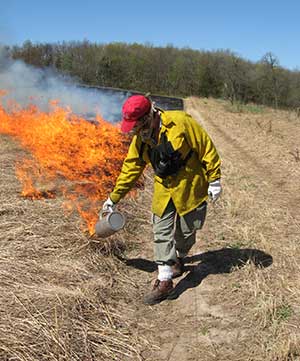Prescribed Fire
Should I burn my land?
This content was originally published in our handbook for landowners, My Healthy Woods. Follow the link at the right to request a free copy.

Historically, many Wisconsin landscapes – especially in the southern part of the state – were strongly influenced by wildfire. But for fire to continue to shape our lands today, prescribed burns must take the place of wildfires.
Prescribed burning is the intentional setting of fire under specific conditions to achieve important land management objectives. For example, prescribed fire can help:
Restore natural communities that depend on fire, such as prairie, oak savanna, and oak woodlands. Periodic fire helps regenerate the trees and wildflowers in these communities.
Improve wildlife habitat by increasing plant production (both the amount of growth and production of seeds), the availability of browse (forcing top-killed shrubs to re-sprout), and habitat for specific species. For example, red-headed woodpeckers forage in open woods maintained by fire.
Control competition between species by reducing encroachment of undesirable shrubs and trees into restored prairies, savannas, and oak woodlands. Fire may only top-kill shrubs or trees, meaning they will re-sprout. But top-killing can prevent woody plants from competing with shorter wildflowers.
Help prepare sites for seeding or mechanical replanting by removing built-up thatch.
Although fire is a very useful land management tool, conducting a prescribed burn safely requires training and experience. Read on to have these questions answered:
How do I conduct a burn on my property?
